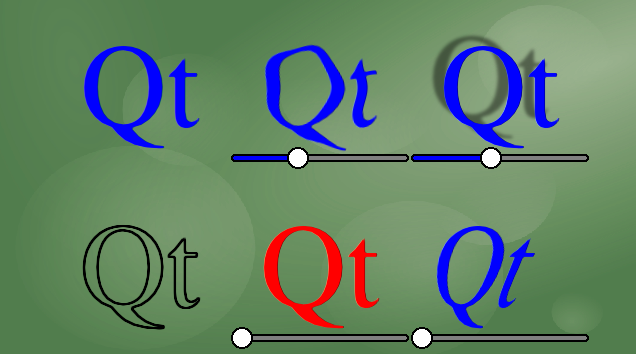Qt Quick Examples - Shader Effects
A Qt Quick example demonstrating the use of shader effects.

This example demonstrates a couple of visual effects that you can perform with shaders in Qt Quick. It applies five different effects on a text and a couple of images. For more information, visit Important Concepts In Qt Quick - Graphical Effects
Running the Example
To run the example from Qt Creator, open the Welcome mode and select the example from Examples. For more information, visit Building and Running an Example.
Using ShaderEffect
The ShaderEffect type typically operates on other types, using a ShaderEffectSource:
ShaderEffectSource { id: theSource sourceItem: theItem }
In the above snippet, theItem is the ID of a complex QML object in the file.
ShaderEffects can use this ShaderEffectSource as a texture in their fragment shader:
fragmentShader: "qrc:shadereffects/content/shaders/wobble.frag"
In order to support multiple graphics APIs, not just OpenGL, the shader source is not embedded into QML. When running with the graphics API independent scene graph, the actual file in use is a pre-generated shader pack containing multiple variants of the shader code. The appropriate shader is then chosen by Qt Quick, regardless of running on Vulkan, Metal, Direct 3D, or OpenGL. Qt automatically selects the file under the qsb selector, for example shaders/+qsb/wobble.frag, when present.
On the traditional code path, which can mean using OpenGL or Direct3D 12, file selectors are used to select the correct variant at runtime. Based on the Qt Quick backend in use, Qt will automatically select either shaders/wobble.frag with the GLSL source code or shaders/+hlsl/wobble.frag with the HLSL source code.
Note: For simplicity shader source code is used in all variants of the files. However, with the Direct3D backend of Qt Quick pre-compiled shaders are also supported. For example, try the following commands in the content/shaders/+hlsl directory: move wobble.frag wobble.frag.src followed by fxc /E main /T ps_5_0 /Fo wobble.frag wobble.frag.src. Now wobble.frag contains Direct3D bytecode and that is what gets shipped with the application instead of the shader source. Further changes are not necessary, the application will function like before.
You can use any custom property on the ShaderEffect in your shader. This makes animated shader code very easy:
property variant source: theSource property real bend: 0 property real minimize: 0 property real side: genieSlider.value SequentialAnimation on bend { loops: Animation.Infinite NumberAnimation { to: 1; duration: 700; easing.type: Easing.InOutSine } PauseAnimation { duration: 1600 } NumberAnimation { to: 0; duration: 700; easing.type: Easing.InOutSine } PauseAnimation { duration: 1000 } } SequentialAnimation on minimize { loops: Animation.Infinite PauseAnimation { duration: 300 } NumberAnimation { to: 1; duration: 700; easing.type: Easing.InOutSine } PauseAnimation { duration: 1000 } NumberAnimation { to: 0; duration: 700; easing.type: Easing.InOutSine } PauseAnimation { duration: 1300 } }
ShaderEffects can also have a custom vertext shader. Setting the mesh property on ShaderEffect provides more vertices for you to manipulate, enabling more effects.
mesh: Qt.size(10, 10) vertexShader: "qrc:shadereffects/content/shaders/genie.vert"